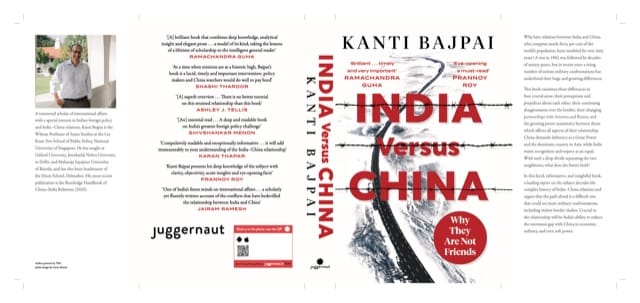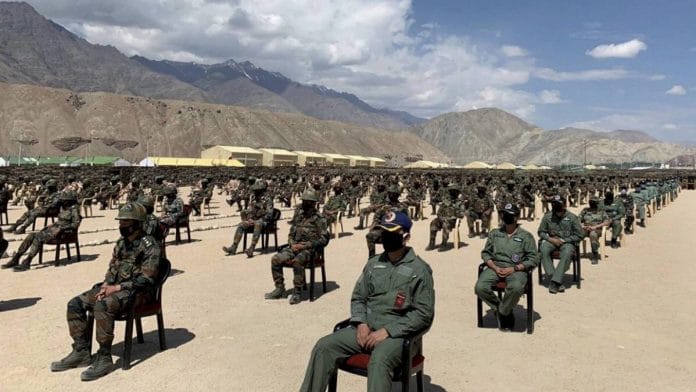India could confront more Galwans ahead. Last year was the bloodiest face-off with China since 1967, but the seven years before that featured a series of disturbing confrontations: Depsang in 2013, Chumar in 2014, Burtse in 2015, and Doklam in 2017. Also in 2017, the Indian Army and China’s People’s Liberation Army got into a scrap at Pangong Tso in the middle of the Doklam crisis.
The frequency of serious confrontations is worrying. Yet, India should not panic. Geography and strategy can work in our favour. Plus, the Indian military is sufficiently matched with China’s.
Military might
Let’s look at military capacity first. India and China have almost the same number of people under arms, indeed India leads slightly in ground forces (1.24 million versus 975,000 troops) [according to the International Institute of Strategic Studies and The Military Balance 2020]. The two countries are also equivalent in terms of artillery pieces (roughly 9,000 each, with India holding a slight edge).
China has 2,285 more tanks than India, but the raw numbers are deceptive. First, Chinese tanks must be deployed against India, Pakistan, Myanmar, Vietnam, North Korea, and Russia. Even with its closest friends, Pakistan and North Korea, China cannot be without armoured defence (that is, tanks). Second, it will also need tanks if it ever invades Taiwan. Third, India by contrast has only two major militaries to worry about (China and Pakistan). Finally, the Himalayan terrain works against major tank battles.
The real military imbalance is in tactical combat capable aircraft where India has 776 and China has 2,517. The picture here is complicated. On the one hand, Chinese forces must be distributed for use against several strong neighbours, including Taiwan and Japan, and against US air power, whereas India’s only worries now are China and Pakistan.
On the other hand, aircraft can be moved around quickly, so the gap cannot be dismissed altogether. To deal with the gap, India is acquiring anti-aircraft missiles (and guns) including the very potent S-400 Triumf missile system from Russia, which will arrive by October/December 2021. It also possesses several other Russian systems including the S-125 Pechoras, the Israeli Spyders, and various Indian systems such as the Akash.
Also read: What does the future of India-China ties look like? 8 experts speak
Terrain troubles
Geography hurts and helps India, but on balance it helps. On the negative side, India’s Himalayan roads twist and turn and rise steeply up to the front, which slows military movement. On the positive side, India’s defences are enhanced by the stopping power of the mountains. Any attempt by Chinese forces to invade beyond a shallow advance would entail traversing those very same difficult roads, making the attack vulnerable to Indian air and artillery fire.
Geography also hampers China’s military logistics. The further the PLA encroaches into India, the longer its supply lines will become and the greater their vulnerability to Indian counterattacks. Indian supply lines, on the other hand, will shorten since in retreat its forces will be closer to their supply centres. Also, while China has good infrastructure leading up to the front, because Tibet is a plateau, its forces and facilities in the rear are susceptible to air and missile fire: it is hard to hide on a flat surface.
Also read: Take Indian Army out of counterinsurgency. It has to tackle leaner, modern PLA
Strategy matters most
India cannot just rely on the size of the militaries and geography for its defence. Strategy matters too. To stop the PLA all along the enormously Line of Actual Control (LAC) is virtually impossible, so to be able to mount a counter-offensive in select areas is vital.
Here India’s mountain strike corps, trained and equipped for high-altitude fighting, is a key asset. Originally, India was to have two such strike corps, but this was financially unviable. It now has just one, which is being modified to fit into the new Integrated Battle Groups (IBGs). The IBGs combine infantry, artillery, and tanks and armoured vehicles designed for quick mobilisation and use, including offensive operations to relieve pressures in other areas.
Also crucial to India’s strategy will be the use of airpower. In 1962, the Indian Air Force was used for transport purposes, not for tactical strikes to help ground forces. Holding the Air Force back is simply not an option in a future war. The Air Force was used in the 1965, 1971, and 1999 wars with Pakistan and in Balakot in 2019. It will have to be used in any major conflict with China to aid the ground war and to interdict Chinese supplies and reinforcements being moved across Tibet.
While India must not panic, there is no room for complacency. China’s ability to prosecute “informatised war” using a combination of computers, internet, artificial intelligence, precision-guided missiles (offensive and defensive), and airborne and satellite imagery is advancing rapidly. India will have to catch up in the years ahead. In the meantime, we can deploy geography and sensible military strategy to limit the Chinese threat in the high Himalayas.
Kanti Bajpai is the author of ‘India Versus China: Why They Are Not Friends’ (Juggernaut Books) published in June 2021, and Wilmar Professor of Asian Studies at the National University of Singapore. Views are personal.

(Edited by Neera Majumdar)






